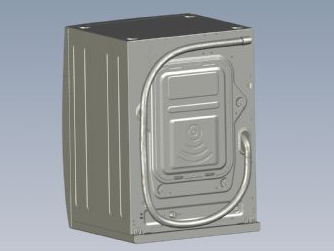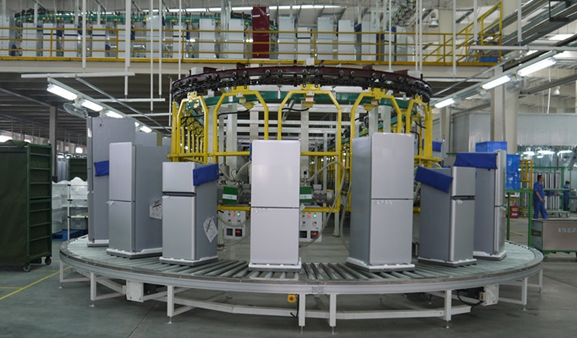
- English
- Español
- Português
- русский
- Français
- 日本語
- Deutsch
- tiếng Việt
- Italiano
- Nederlands
- ภาษาไทย
- Polski
- 한국어
- Svenska
- magyar
- Malay
- বাংলা ভাষার
- Dansk
- Suomi
- हिन्दी
- Pilipino
- Türkçe
- Gaeilge
- العربية
- Indonesia
- Norsk
- تمل
- český
- ελληνικά
- український
- Javanese
- فارسی
- தமிழ்
- తెలుగు
- नेपाली
- Burmese
- български
- ລາວ
- Latine
- Қазақша
- Euskal
- Azərbaycan
- Slovenský jazyk
- Македонски
- Lietuvos
- Eesti Keel
- Română
- Slovenski
- मराठी
- Srpski језик
Analysis of the blanking process of household appliances: Taking the washing machine shell and the inner and outer panels of refrigerators as examples
2024-08-30
In the production of modern household appliances, the blanking process is a crucial part of the manufacturing process. The blanking process lays the foundation for the functionality and appearance of household appliances by cutting metal sheets into the required shape and size. This article will briefly discuss the blanking process of washing machine shells and refrigerator inner and outer panels, and expand to other accessories with the same process.
1. Overview of blanking process
The blanking process mainly includes steps such as raw material preparation, mold design, blanking operation and post-processing. Metal sheets can be punched into required parts through high-precision punching machines and molds. These parts will then be used to assemble into the final household appliance products. The blanking process requires not only high precision, but also stability and efficiency of the production process.
2. Blanking process of washing machine shell
①. Material selection: Washing machine shells are usually made of cold-rolled steel plates or stainless steel plates. Cold-rolled steel plates are widely used because of their good formability and economy. The material thickness is generally between 0.8mm and 1.5mm, and stainless steel plates are often used in high-end washing machines to improve corrosion resistance and appearance quality.
②. Mold design: The blanking mold of the shell needs to be designed to fit the complex curved surface of the shell. The precision of the mold directly affects the size and shape of the shell. Usually, the blanking of the shell is divided into two steps: rough punching and fine punching. Rough punching removes most of the waste, and fine punching ensures the final dimensional accuracy and surface finish.
③. Blanking operation: The choice of blanking machine affects production efficiency. Hydraulic blanking machine or mechanical blanking machine can adjust the blanking parameters such as pressure and speed according to production needs. During the production process, the blanking machine needs to be regularly inspected and maintained to ensure the stability of production.
④. Post-processing: The shell after blanking usually needs to be deburred, cleaned and surface treated. Deburring can be done by a deburring machine, the cleaning step removes surface dirt, and the surface treatment includes spraying or electroplating to enhance the durability and aesthetics of the shell.


3. Blanking process of inner and outer panels of refrigerators
①.Material selection: The inner panels of refrigerators are generally made of stainless steel plates, which have excellent corrosion resistance and cleanability. The outer panels are mostly made of cold-rolled steel plates, and galvanized to increase corrosion resistance. The material thickness is usually between 0.7mm and 1.2mm.
②. Mold design: The mold design of the inner and outer panels of the refrigerator needs to take into account the shape and thickness requirements of different parts. In particular, the inner panel needs to be designed to have a certain structural strength to support the internal insulation material and condensation pipeline.
③. Punching operation: The operation of the punching machine includes setting the appropriate pressure and speed to meet the punching requirements of different plates. The punching parameters need to be strictly controlled during the production process to ensure the accuracy and consistency of the parts.
④. Post-processing: The inner and outer panels of the refrigerator after punching need to be deburred, cleaned and surface treated. The inner panel usually needs to be treated with anti-corrosion, and the outer panel needs to be sprayed to improve the appearance and durability.
4. Other accessories with the same process
In addition to the washing machine shell and the inner and outer panels of the refrigerator, many household appliance parts also use the punching process. For example:
①. Microwave oven shell: The punching process of the microwave oven shell is similar to that of the washing machine shell, mainly using cold-rolled steel plate or stainless steel plate. The shell needs to be precision punched and surface treated to ensure its appearance and radiation protection function.
②. Air conditioner shell and panel: The shell and panel of the air conditioner are generally made of cold-rolled steel plate or aluminum alloy plate. The punching process needs to take into account the requirements of heat dissipation and installation holes, and the surface treatment includes spraying or baking paint to improve durability and aesthetics.
③. Rice cooker liner: The rice cooker liner is usually made of stainless steel plate, which is punched, deep-drawn and surface-treated to form an liner with an anti-stick coating. The punching process ensures the accuracy and structural strength of the liner during this process.
④. Oven liner: The oven liner is usually made of high-temperature resistant stainless steel. The punching process includes precise mold design and strict process control to ensure the high temperature resistance and hygienic performance of the liner.
5. Summary
The punching process of washing machine shells and refrigerator inner and outer panels is a key link in the production of home appliances, involving multiple steps such as material selection, mold design, punching operation and post-processing. Through these processes, the functionality and appearance quality of the final product are ensured. Similar punching processes are also widely used in the production of other home appliance components, such as microwave oven shells, air conditioner panels, rice cooker liner, etc. With the advancement of technology, the blanking process will continue to be optimized, promoting the further development of the home appliance manufacturing industry.



